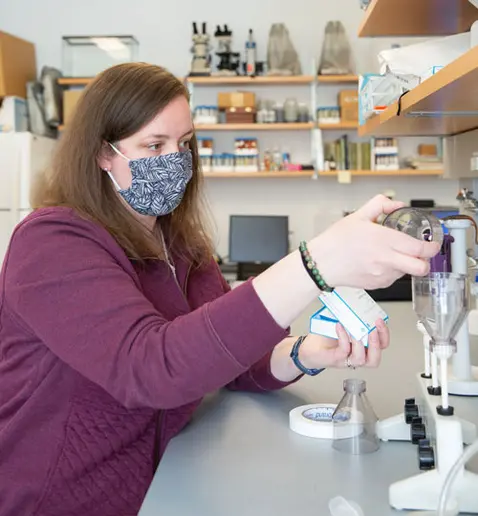

Dr. Courtney Wigdahl-Perry in a Science Center lab.


Dr. Courtney Wigdahl-Perry in a Science Center lab.
A team of research scientists that included Fredonia Department of Biology Associate Professor Courtney Wigdahl-Perry led a panel discussion to provide information on water quality research they have conducted at Chautauqua Lake in a virtual presentation hosted by Chautauqua Institution’s Virtual Porch.
It was the second water quality research panel convened by the Chautauqua Lake & Watershed Management Alliance, based in Jamestown and comprised of 24 member organizations. Panel members that included faculty, staff and graduate students from SUNY Oneonta and Bowling Green State University and staff from The Jefferson Project at Lake George also outlined future research during the presentation.
“The lake is a critical hub in Western New York for a variety of activities, such as tourism, fishing and recreation activities, and also serves as a drinking water source for some of our local communities,” said Dr. Wigdahl-Perry, who directs Fredonia’s Environmental Sciences program.
Wigdahl-Perry’s presentation, the first of four in the virtual program held on April 10, was focused on her work with aerial surveillance of algae blooms that utilized hyperspectral imaging and drones to track bloom dynamics. She described the inland lake, which contains some 13,000 acres of surface area and is relatively shallow for its size, as being moderately to highly productive for plant and algae growth, so it’s susceptible to frequent or persistent harmful algae blooms (HABs).
The lake is distinguished by its dual basin configuration, with a deeper north basin that flows into the shallower south basin.
“What we see in some lakes is a greening process; we go from clear water to more of a turbid algae-dominated state over time,” Wigdahl-Perry explained. This change, called eutrophication, can be a naturally occurring process that leads to increasing productivity or photosynthesis, as plants and algae convert sunshine to sugars. However, Wigdahl-Perry described how cultural eutrophication can occur when the growth rate of algae is accelerated by human activity on and around the lake.
One of the ways human activity increases cultural eutrophication is through deposits of excess nutrients, such as nitrogen and phosphorus, into the lake ecosystem.
“When we have a lot of those (nutrients) coming into the ecosystem, that can allow this really rapid growth of algae. This is where we get the harmful algae blooms,” Wigdahl-Perry said.
There are important ecological considerations, such as public health consequences, Wigdahl-Perry explained, “that occur as a result of HABs, which is why it is so much of a focus not only in Western New York and in the United States, but truly around the world.”
Wigdahl-Perry reviewed tracking methods or practices used to monitor algae, such as microscopic counts, measuring toxin concentrations and examining water chemistry or nutrient levels, and use of a Secchi disk to determine water clarity.
In her research lab, Wigdahl-Perry is working to gain a greater understanding of how algae blooms originate, grow, move and ultimately decline or fade by accessing different kinds of data. “We don’t have a good sense of the lifespan process of blooms in Chautauqua Lake,” Wigdahl-Perry said.
“You might see a bloom in one part of the water and then motor across to the other side of the lake and have a very different water clarity or bloom state,” Wigdahl-Perry explained.
The use of drones equipped with hyperspectral imaging equipment greatly enhances the ability to track the full spectrum of algae spatially in the lake. Previously, reports of algae were compiled mostly in limited areas where human activity occurs, such as beaches and marinas. These traditional methods of monitoring algae “tell us where (algae) are, but not where they aren’t,” she noted.
Hyperspectral imaging technology is far superior to the use of satellites for tracking blooms throughout the lake, Wigdahl-Perry noted. Their prevalence or frequency can vary greatly from one location on the lake to another. This technology will also be utilized in similar research underway in Seneca, Keuka and Otsego lakes.
Wigdahl-Perry indicated the research team on this project, funded by Corning, Inc., is comprised of computer scientists, remote sensing specialists, lake ecologists, physicists and science education experts. The four presentations were followed by a question/answer session.
Research activities were suspended last year due to the coronavirus pandemic, but Wigdahl-Perry is looking forward to resuming work in 2021.
Wigdahl-Perry is excited to have new colleagues conducting scientific research in Chautauqua Lake. “It’s going to be wonderful for our community, great for our students and their educational experience and to be able to learn more about the lake than we could have before,” she said.
Three Fredonia undergraduates – Kasey Crandall, Autumn Fisher, Madison Mitchell – will be involved in Wigdahl-Perry’s research this summer and fall; a graduate student is expected to begin research this fall.
The power of collaboration exhibited by the researchers goes beyond the scientific investigations they presented, said Randall Perry, executive director of the alliance. “It means so much to the future our exquisitely dynamic and complex Chautauqua Lake, supporting a spectrum of uses and users, economically, ecologically and culturally,” Mr. Perry said.
The full panel discussion can be viewed online.